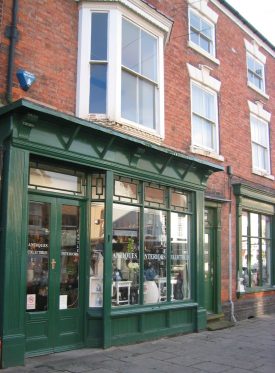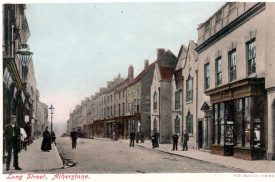The brick-built building known as 47 Long Street is located on its south side, when travelling from east to west, and is dated 18271. During the first four decades of the 20th century, it was the business premises of John Cooper Barnsley. John Cooper Barnsley’s life is an example of the Edwardian self-made man. He was born in Atherstone in 1869 and raised there. His father, Samuel, was a bricklayer, but John Cooper Barnsley worked his way up from modest beginnings to be the owner of his own business in the town’s principal street by the age of 42, and died a wealthy man, aged 73, in 19432.
Two distinct businesses
Some of the history of these premises from the early years of the 20th century to the 1920s can be traced in Mr Barnsley’s account books held at Warwickshire County Record Office3, whilst entries in Kelly’s Directory of Warwickshire confirm that he continued his business there until 1940. It appears that Mr Barnsley was running two very different types of undertaking on the same site. In Kelly’s… from 1908 to 1928, he was listed as a “mineral water manufacturer” at 47 Long Street whereas in the 1911 Census he described himself as an “outfitter and employer”, with no indication of any other type of commercial activity. From 1928 to 1940, he was listed in Kelly’s... simply as “draper”. Was it possible for an individual to run two distinct businesses simultaneously for about 20 years from the same premises? Evidently John Cooper Barnsley did. Self-belief was one thing but he would have needed additional assets, such as physical space. This was important, given the different types of enterprise he was running.
Accommodating both businesses
How might manufacturing – noisy, needing room for plant and equipment and storage of stock – and the world of shop-keeping – quieter and more ‘genteel’ – be met and accommodated within one messuage? Mr Barnsley already had some of the basics for mineral water production in the form of a water supply and outbuildings behind 47 Long Street4. These were a place to produce and store the finished product as well as offering ease of access to the street for deliveries.
Turning to the “drapery” side, stock such as rolls of cloth, bales of household linen and so on, even though bulky, would have been easier to move into and around the interior of number 47 where they were less vulnerable to damage from the manufacturing process. With the retail premises on the ground floor, the first and second floors of number 47 were available for family living space as well as stock- and work-rooms. The 1911 Census entry shows that the family ‘lived over the shop’ whilst the second (top) floor could have been used as a workroom for the bespoke tailoring side, as well as storage for textiles which had to be kept dry and clean. A printed heading dated 21 December 1901 refers to:
John C. Barnsley
General Outfitter and Furnisher
Boots and Shoes, Furniture, Wringing Machines,
sewing machines, watches, clocks, clothing, ready made and made to measure,
haberdashery.
It may be that this is the clue to how the two enterprises might be accommodated within one site. Any reader asked to move their grandmother’s or great-grandmother’s mangle can testify to the difficulty of shifting one. The wringing machines (mangles), furniture, and sewing machines listed in Mr Barnsley’s letter heading were heavy and bulky items, not easily moveable in confined spaces and so the outbuildings at the back of number 47 might well have been the meeting point of his two businesses, where serviceable sheds or barns opening onto ground floor yards, accessible to and from the street, could be used for both his undertakings.
Potential markets
As far as potential markets for the diverse goods and services Mr Barnsley offered, there was demand for safe drinking water in the town, given the over-crowded and insanitary housing away from the main streets. However, clearance of these slums began in the late 1920s5. Had this reduced or destroyed the market for “mineral water”? Did these urban improvements push John Cooper Barnsley into abandoning its production? If so, this would explain the alteration to his entry in Kelly’s… so that there are no further references to it after 1928. On the other hand, his drapery and furnishing business appears to have gone from strength to strength in the inter-war period. A discussion of this is the subject of a further article.
References:
1 Nat Alcock and Margaret Hughes (eds.), Atherstone: A Pleasantly Placed Town (Chichester, Phillimore &Co. Ltd, 2008), p. 227
2 National Probated Calendar 1944: John Cooper Barnsley, Bachelors Bench, Atherstone, died 2 May 1943; personal estate valued at £3,871. 9s. 1d
3 CR 2099
4 Alcock and Hughes, Atherstone, pp. 164-165
5 Ibid, p. 178









Comments
I recall, in the 1940-50 period, the store was still being run by Connie Barnsley, possibly a daughter. She was a large, unmarried lady, who dressed in 1920-30s style.
Connie was my music teacher
Nymphs and Shepherds
North junior late 50s
Add a comment about this page